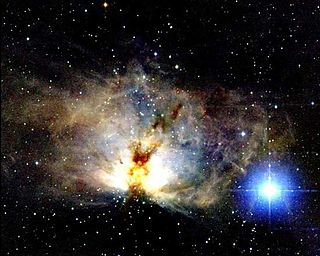This page is based on this
Wikipedia article Text is available under the
CC BY-SA 4.0 license; additional terms may apply.
Images, videos and audio are available under their respective licenses.

Orion is a prominent constellation located on the celestial equator and visible throughout the world. It is one of the most conspicuous and recognizable constellations in the night sky. It was named after Orion, a hunter in Greek mythology. Its brightest stars are Rigel and Betelgeuse, a blue-white and a red supergiant, respectively.

Mintaka, also designated Delta Orionis and 34 Orionis is a multiple star system some 1,200 light-years from the Sun in the constellation of Orion. Together with Alnitak and Alnilam, the three stars form Orion's Belt, known by many names among ancient cultures. When Orion is near the meridian, Mintaka is the right-most of the Belt's stars when viewed from the Northern Hemisphere facing south.

In stellar evolution, an FU Orionis star is a pre–main-sequence star which displays an extreme change in magnitude and spectral type. One example is the star V1057 Cyg, which became 6 magnitudes brighter and went from spectral type dKe to F-type supergiant. These stars are named after their type-star, FU Orionis.

Alnitak, also designated ζ Orionis and 50 Orionis, is a triple star system several hundred parsecs from the Sun in the constellation of Orion. It is one of the three main stars of Orion's Belt along with Alnilam and Mintaka.

Iota Orionis is a multiple star system in the equatorial constellation of Orion the hunter. It is the eighth-brightest member of Orion with an apparent visual magnitude of 2.77 and also the brightest member of the asterism known as Orion's Sword. It is a member of the NGC 1980 open cluster. From parallax measurements, it is located at a distance of roughly 2,300 light-years from the Sun.

Chi1 Orionis is a star about 28 light years away. It is in the constellation Orion, where it can be seen in the tip of the Hunter's upraised club.

Meissa, designated Lambda Orionis is a star in the constellation of Orion. It is a multiple star approximately 1,100 ly away with a combined apparent magnitude of 3.33. The main components are an O8 giant star and a B-class main sequence star, separated by about 4".

Pi³ Orionis, also named Tabit, is a star in the equatorial constellation of Orion. At an apparent visual magnitude of 3.16, it is readily visible to the naked eye and is the brightest star in the lion's hide that Orion is holding. As measured using the parallax technique, it is 26.32 light-years distant from the Sun.

Sh2-279 is an HII region and bright nebulae that includes a reflection nebula located in the constellation Orion. It is the northernmost part of the asterism known as Orion's Sword, lying 0.6° north of the Orion Nebula. The reflection nebula embedded in
Sh2-279 is popularly known as the Running Man Nebula.

Eta Orionis is a multiple star in the constellation Orion. It lies a little to the west of Orion's belt between Delta Orionis and Rigel, being closer to Delta Orionis than to Rigel. It lies at a distance of around 1,000 light years from Earth and is part of the Orion OB1 association.
The Bayer designation θ Orionis is shared by several astronomical objects, located near RA 05h 35m DEC −05° 24′:
V1057 Cygni (V1057 Cyg) is a FU Orionis-type variable star in the constellation of Cygnus. It has a spectral type of F and an apparent visual magnitude of approximately 11.660. It was the second FU Orionis-type variable discovered.

U Orionis is a Mira-type variable star in the constellation Orion. It is a classical long period variable star that has been well observed from the United Kingdom for over 120 years.

25 Orionis, less commonly known by its Bayer designation Psi1 Orionis is a fifth-magnitude star in the constellation Orion. It lies among a dense cluster of low-mass pre-main-sequence stars in the Orion OB1a.

μ Orionis is a quadruple star system in the constellation Orion, similar to Mizar and Epsilon Lyrae with combined visual magnitude of 4.13. The four stars are known as Mu Orionis Aa, Mu Orionis Ab, Mu Orionis Ba, and Mu Orionis Bb. All four components are spectroscopic, with A and B systems only several tenths of an arcsec apart. The entire system is located approximately 155 Light Years from the Sun.

Omega Orionis is a star in the constellation Orion. Its apparent magnitude is 4.57 and is located approximately 1,400 light years from our solar system. It is surrounded by a cloud of dust, forming a modest reflection nebula over a light-year wide.

Theta1 Orionis A is a variable trinary star in the constellation Orion. Its apparent magnitude range is 6.72 to 7.65 with a period of 65.432 days. It is one of the main stars in The Trapezium in Orion, along with B, C, and D, as well as the fainter E.

VV Orionis is an eclipsing binary located in the belt region of the constellation Orion. It is a faint naked eye star.
DN Orionis is an Algol variable located in the constellation of Orion. The primary star is a spectral type A2e star and the secondary star is a spectral type gF5 star.
GW Orionis is a T Tauri type pre-main sequence hierarchical triple star system. It is associated with the Lambda Orionis star-forming region and has an extended circumtrinary protoplanetary disk.











